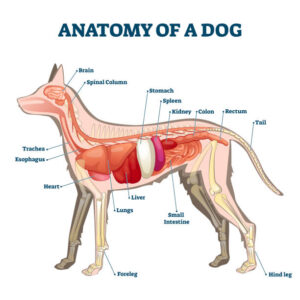The nervous system of a dog comprises of the dog’s brain, spinal cord, and the nerves traveling between the two and throughout your dog’s body. The nervous system controls a dog’s actions, from movement to play, to eating and to emotional behavior.
A neurological disorder in a dog can occur as a result of external factors like an injury, a reaction to medication, hereditary diseases, or general health problems. Find out some common neurological problems that can impact on a dogs life, as well as some breed-specific disorders to watch for.
Neurological Disorders (Ageing)? Due to leading advancements in diagnosing and treatments that are now available, there are now many options available to families with an ageing dog.
As your dog ages, it is more important than ever to be observant and note any changes in behavior, balance loss or incoordination that may be passed over as just ‘old age’.
For example, it could be the start of a disease that could easily be treated in it’s early stages. While these disorders can be devastating to owners and frustrating to deal with, the sooner you get help from a vet the better it will be for your dog.
As your dog ages, risks of developing neurological disorders such as strokes, brain tumours and neurodegenerative disorders increases which may compromise their quality of life.
SYMPTOMS OF NEUROLOGICAL DISORDERS (AGEING) IN DOGS
Changes in activity levels.
A reluctance to venture out or join in any high energy activity.
Changes in their sleep pattern.
Wandering around during the night.
Spinal pain.
Limb weakness.
Lack of coordination.
Unexplained changes to their normal temperament.
Balance problems such as wobbling and unsteady gait.
Urinary or faecal incontinence that may result in house soiling.
Vision loss or impairment.
Convulsive seizures.
Disorientation.
Lethargy Anxiety.

EPILEPSY IN DOGS
Perhaps one of the most well-known neurological disorders is epilepsy, which is characterized by recurrent seizures. Epilepsy can be caused by trauma, like a head injury, or metabolic issues, but the causes can also commonly be idiopathic, meaning that vets are not quite sure why the dog has the disease.
Treatment of epilepsy is aimed at reducing how long the seizures last and how frequently they take place. While the seizures can be quite scary, the day-to-day quality of life for a dog with epilepsy often remains high.
HEREDITARY DISEASES IN DOG BREEDS
Some neurological problems are the result of inherited conditions; however with careful breeding, these kind of diseases can often be avoided.
Dancing Doberman Disease: This disease affects Dobermans only, and causes the gastrocnemius muscle, located in the dog’s legs, to flex and extend. Dogs will eventually avoid standing entirely to avoid this uncontrollable movement. Both males and females can get this disease.
Scottie Cramp: As with Dancing Doberman Disease, Scottie Cramp is a disease that impacts a dog’s legs. Only affecting Scottish Terriers, this disease is carried by a recessive gene, and can be eliminated through proper breeding. Scottish Terriers that have this disease will hyper-extend and hyper-flex their legs, and experience leg spasms.
NEUTRAL DISEASES ASSOCIATED WITH DOG BREEDS
Some neural diseases, while not necessarily hereditary in nature, are closely associated with specific breeds of dogs.
White Dog Shaker Syndrome: While not exclusively experienced by dogs with white fur, a large number of dogs with this syndrome are white. The causes of the disease are unknown. Dogs with this condition shake and tremble. Corticosteroids can be used as a treatment method if the causes are neurological in nature.
Cauda Equina Syndrome: Also known as Lumbosacral stenosis, this arthetric condition occurs in a dog’s hind legs. It’s quite painful, especially when dogs lie down. Dogs can also have trouble urinating or defecating as a result. Cauda Equina syndrome occurs because of a narrowing in the dog’s spinal column, and can be easily confused with hip dysplasia. Large breeds, especially German Shepherds and Greyhounds are most commonly affected.
ACQUIRED NEUTRAL DISEASES
These diseases, which greatly impact a dog’s neurological system are caught from other dogs or animals, or caught through exposure.
Tick Paralysis: All ticks are problematic, but some females will transmit poison to dogs during the biting process, which will cause paralysis and breathing difficulties. These nervous system problems will occur within a few days of the bite, and with the removal of the tick. The symptoms will generally dissipate. In some cases, hospitalization will be required.
